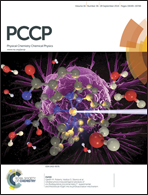EPR investigation of TiCl3 dissolved in polar solvents – implications for the understanding of active Ti(iii) species in heterogeneous Ziegler–Natta catalysts†
Abstract
Multi-frequency continuous-wave and pulsed EPR techniques are employed to investigate Ti(III)-chloro complexes obtained by dissolving TiCl3 in anhydrous and hydrated methanol. Two distinctly different species, characterized by different g matrices are observed in the two cases. Hyperfine sublevel correlation (HYSCORE) spectroscopy is found to be a powerful method to identify the type of nuclei surrounding the Ti3+ ion. For the first time, the hyperfine and nuclear quadrupole data of Ti(III)-bound 35/37Cl nuclei are reported together with 1H and 13C hyperfine data of the coordinated methanol molecules. DFT modelling allows interpreting the measured spin Hamiltonian parameters in terms of microscopic models of the solvated species. The theoretical observable properties (g matrix, 35/37Cl, 1H and 13C hyperfine tensors) are in quantitative agreement with the experiments for two families of complexes: [TiCln(CH3OH)6−n](3−n)+ (with n ranging from 1 to 3) and [Ti(CH3OH)5(OH)]2+ or [Ti(CH3OH)5(OCH3)]2+. The first complex is observed in anhydrous methanol, while the second type of complex is observed when water is added to the solution, the presence of OH− and/or CH3O− species being promoted by water hydrolysis. The results obtained for the frozen solutions are critically compared to EPR spectra recorded for a MgCl2-supported Ti-based Ziegler–Natta model catalyst.


 Please wait while we load your content...
Please wait while we load your content...